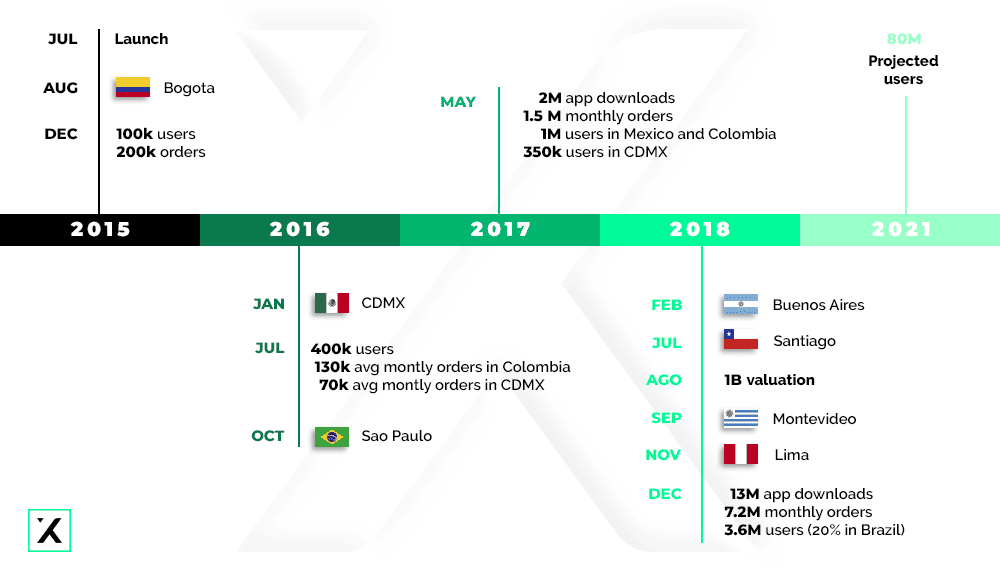Contxto – Pay no heed to what seems to be Rappi’s trudge through the murky waters of controversy. On a grander scale, this last-mile delivery company’s growth strategy is going full-throttle.
When it comes to rapid regional expansion and collaboration, this scaleup is queen.
Not only does it continue to integrate itself with various other ventures but it also seems to launch in a new Latin American country every other day. Its latest expansion Ecuador earlier this year.
Juan Felipe Rozo Casas, Rappi’s Growth Manager, actually says that beyond Ecuador they’ve got a few additional undisclosed destinations, but “that expansion that cannot be mentioned for commercial issues.”
To Mr. Rozo, growth is encoded into the four-year-old app’s DNA.
Undoubtedly, while there’s a lack of data surrounding its Brazilian, Peruvian, and newest Ecuadorian markets, there’s no denying that the company is reaching one milestone after another. With that said, this piece examines the evolution of Rappi’s expansion.
How is it than an app founded in 2015 is well on its way to becoming a Latin American “super-app” where so many others have failed?
Rappi’s regional muscle
Rappi services are available in Argentina, Brazil, Chile, Mexico, Peru, Ecuador, as well as Uruguay. In its native Colombia alone the app has about with around 20,000 delivery drivers running around some of the country’s busiest streets.
Estimates have this unicorn’s current mobile workforce at 100,000 “rappitenderos” (a cooky nickname for their delivery personnel) in seven Latin American markets. By 2021, it expects to achieve 80 million international users.

Mexico
While it seems like an underestimate, some sources calculate that Mexico has around 9,500 people working for Rappi. This number is likely higher, though, considering that Mexico was the first country where Rappi premiered internationally in January 2016. Since then, Rappi has made some interesting insights about Mexican consumers.
“We have noticed that during the week people take care of themselves a little more with healthier products, and on weekends users ask for everything,” said Rappi to Mexican newspaper, El Financiero.
Lately, Latin America’s largest Spanish-speaking country has also seen a monthly growth rate of 20 percent in Rappi orders. As of today, Rappi is present in Mexico City, Guadalajara, Monterrey, Puebla, Querétaro, Mérida, Santa Fé, as well as Satélite, a staunchly middle-class enclave in suburban Mexico City.
Recent coverage from Fortune en Español claimed that Rappi’s recent billion-dollar SoftBank investment will allow it to add half a million new users. And since Mexico represents one of the largest portions of Rappi’s Latin American operations, the country will reportedly receive a 6 million pesos (around US$300,000) from these SoftBank funds.
Of this fresh cash, the Rappi has earmarked funds to be used by the end of the year for an additional 5,000 rappitenderos, as well as the integration of five new cities. They will include Chihuahua, Culiacán, Hermosillo, Tijuana, and Toluca.
“Mexico represents about a third of all the volume that Rappi has, so we would expect that around 300 million to 350 million dollars will enter the 1,000 million round in Mexico,” said Alejandro Solís, director of Rappi Mexico. “This will be developed in the next 12 to 24 months, depending on the speed of growth.”
Brazil
So far, no sources have released any hard data about Rappi’s operations in Brazil. Shame, because this South American titan will certainly have some big numbers to offer.
Nonetheless, we know that Rappi debuted in São Paulo during October 2016. We also know that some of the startup’s SoftBank money will go towards tripling the number of Brazilian cities it serves. Reuters claims that the number will grow from 20 to 70.
So brace yourselves because, while Rappi recently experienced a five-fold sales increase over the past year, its Brazilian market increased by 24 times in the same period.
Argentina
February 2018 marked the beginning of Rappi’s operations in Argentina. Despite legal trouble and labor rights issues, the company has reportedly been providing income to 13,000 delivery drivers over the past year. According to reports, it intends to dispute and appeal the decision by the end of next week.
This, of course, is a mixture of the company’s growing pains, but also a reflection of the disruption the company’s business model has caused within the region’s Latin American regulatory framework.
This is not the first (as we will see later in this piece) or last time Rappi will find itself in trouble. Meanwhile, platitudes were what the company had to offer on its Argentinian legal qualms: “We will continue to ensure the interests of all parties, with the same commitment as always,” it said in a press release.
Chile
Operations in Chile began in July 2018 within the capital city of Santiago. Chilean media outlet FayerWayer projects that over 40,000 users have downloaded Rappi for work purposes. All the while, between 10,000 and 15,000 deliverers are expected to be active over the platform.
Most recently, Rappi also premiered its first B2B (business to business) delivery service in the Andean country known as RappiEntregas. Earlier this month, it also launched services in its third Chilean city, Concepción, following Santiago and Viña del Mar.
Uruguay
One of the youngest Rappi markets is Uruguay, launching in the capital city of Montevideo in September 2018. According to El Observador newspaper, the small South American country wedged between Brazil, Argentina and Paraguay boasts between 8,000 and 8,500 distributors.
But don’t smirk at its population of 3.5 million. Uruguay has one of the most stable middle-classes, democratic governments, and “digital developments” within Latin America. A sure hit for an app like Rappi.
Peru
Another new market within Rappi’s network is Peru, only arriving in November 2018. This expansion was the lovechild between a US$10 million investment and strategic alliance with DILOO, a mobile app easing communication between customers and companies with its chat platform.
This way, the company was able to offer over 100,000 products to consumers in the capital city of Lima.
The country’s fast economic growth and concentrated urban areas—keep in mind that virtually half the country’s population lives in its capital city—was bound to attract Rappi at some point.
“For a long time, we have been working to reach a country as important as Peru,” confirmed Simón Borrero, CEO Rappi.
Ecuador
This latest expansion is a tribute to this startup’s growth. The app has barely been available for a month in Ecuador and 100,000 people have already subscribed to its services. That is almost 6 percent of the city of Quito in a matter of days.
Rappi certainly seems to be giving the people what they want—and at their doorstep.
Everything app = strange collaborations
We have seen just four years of operation and Rappi has already transcended various sectors while growing at astonishingly fast rates. Approximately US$220 million worth of transactions have reportedly gone through between users and drivers.
It’s no secret that Rappi is aspiring to become a world-class “super-app” based on its collaborations with other companies. All the while, Rappi has raised some eyebrows regarding its “versatility” offering everything from e-scooter rentals with Grin to purchasing airline tickets via Voopter.
Such a seemingly random portfolio has left many consumers confused over Rappi’s business model. While it’s admirable for any startup to shoot for the stars, a complicated UX (User Experience) could really kill their momentum.
Much of Rappi’s success is also due to its major funding rounds. As mentioned above, this past April saw SoftBank lead a Series E worth US$1 billion. Past investments have also involved DST Global, Delivery Hero, Sequoia Capital, Andreessen Horowitz, as well as Y Combinator.
Not all rainbows and startup unicorns
Regardless—or perhaps because of—its fast progress, Rappi’s business model has received some flack.
Regulations, though often vilified by business, do serve a purpose. They help protect consumers and employees. Yet, Rappi’s disruptive model has often been able to bypass these controls.
Take the debate over public space, and rappitenderos’ use of it. Groups of fit, young people loitering outside shops can sometimes worry those more, let’s call them, “safety-minded people”.
More serious is the debate over whether the use of public space by a private company for its own benefit is acceptable or not. Some Colombian cities have decided that it is not; charging the company for its use of space.
Another important concern is whether the claim to “versatility” is, in fact, a front for worker exploitation. Rappitenderos are basically working-class free-lancers, bereft of benefits, not to mention the lack of safety nets. These include car or health insurance.
The company seems to be reacting to some of these criticisms. They are, for instance, opening up “pitstops” for its delivery force.
Ultimately though, for many, this is an issue that transcends borders and industries. Stefano Farne, director of the Labor Observatory of the Externado University, sums it up by saying that this isn’t a Colombian or a Latin American issue, “it is a worldwide problem. We are all trying to understand how to best use the internet.”
Indeed, whether we end up using it for good or for ill, the future will be in the hands of digital giants like Rappi—as well as those of the citizens of the countries it operates in.
-JA






